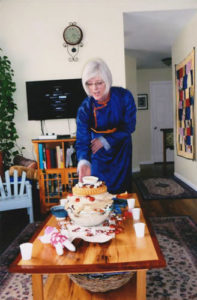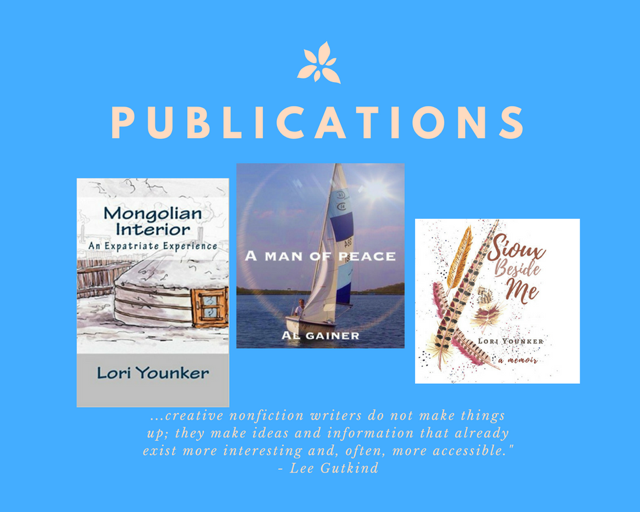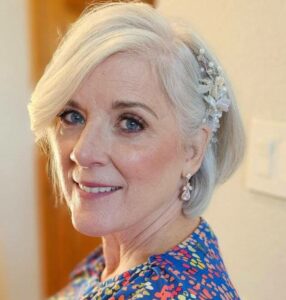Bowls of hot, brown water sat on the table before us. The blue and white ceramic bowls meant for rice held what we presumed was tea, poured carefully from a tall, handsome thermos with a Mongolian warrior painted on the front.
My husband and I were visiting with our three children at the home of my language tutor, Bor. For respect we called her Borehkjee which meant Older Sister Brown. She was a woman of short stature, sparkling eyes above high cheekbones, permed black hair. On that day, she wore the traditional, shiny Mongolian dress called the del. Though it wasn’t a holiday, we were her special guests, and this was our first cup of Mongolian milk tea.
When our hostess left for the kitchen to bring back other treats, we dared each other to have our first sips.
“It’s so salty,” said Pete.
“Think of it as soup,” suggested Dad. “Then it will be easier to drink.”
It’s the color of dirty dishwater, I thought, but didn’t say aloud.
“Can I have some koolaid?” six-year old Mary asked innocently.
Though the change from the Soviet system to democracy in 1990 impoverished the nation as a whole, Borehkjee pulled out all she had, serving us a meal to remember.
“Eat, Eat!” she coaxed us over and over again.
There were mounds of bread and jam, the always-present candy bowl, plates of Russian-style potato salad, coleslaw, carrot salad, and mutton dumplings. These dumplings were placed in the center of the table, steaming hot, filled with generous amounts of meat. These were holiday foods, and Borehkjee honored us with them. The Mongolian hospitality so pure, soon became the filter through which I viewed the milk tea–as something pure, as something grand.
Milk tea the world over is well-known in countries with British influence. A little dollup of cream or half-and-half is poured from sweet little pitchers into fancy tea cups. Not so for the Mongolian version. Theirs takes several exhaustive steps and takes on the role of a meal over the centuries. If there would be no food in the yurt for the weary traveler who came through, the milk tea would not only warm him, it would sustain him for a few more hours.
When we stayed in the countryside once, we saw the milk tea made from beginning to end in the traditional way.
First, one of the family members plods down the hill for for spring water. They carry it back in a large metal jug, pulled on a little trolley art behind them. Meanwhile, the grandmother stokes the fire of dung patties in the hot wood stove in the center of the yurt. The large wok is placed atop the stove and she throws a sheep tail into the wok. The fat sizzles and releases nourishing oil to receive a handful of barley grain which is fried and moved about with a long spoon. Soon, the contents of the wok look like a buttery paste and is ready to receive the spring water and the unique green tea out of Russia.
Since this Russian tea comes in a block, the hostess breaks off a section and lets it fall into the hot water. It breaks apart and flavors the water. Grandmother keeps stirring and adds a palmful of salt. She stirs some more. But it is the final, dramatic step which becomes that rhythmic, almost musical as we watch the hostess pour in the milk, for now she ladles the mixture up and down, her arm high in the air. Up and down she pours the tea from the ladle to fall back into the wok, giving life to the tea, making it frothy and light. By now, the loose tea has floated to the bottom of the kettle and the grandmother pours the tea carefully into the tall thermos set on the floor between her legs.
Grandmother pours out bowls of tea for us and hands one to my husband first and then one to me in the Mongolian traditional way, her right hand extended with the hot bowl nestled in her hand, extended to where we sit in seats of honor facing the door. Her left hand is placed gently under her right elbow, which I learn is the way to hand anyone a gift if you can’t give with both hands or without losing your balance. Left under the right will suffice.
Experts on Asian cooking would say that the layer of oil in the tea acts as a layer of insulation to keep the tea from cooling off too quickly. Also, popular YouTuber “Nargie’s Mongolian Cuisine” says that the most delicious way to make milk tea is with the fat from the sheep tail, flour, millet–as opposed to barley– and he includes Mongolian butter. At the Comfort Inn of Darkhan, the master chef cooks slices of fat from the sheep tail with flour and millet until the paste is golden brown. And in the final steps, she adds water, milk, borts-dried meat, a cup of strong pre-made tea, and finally salt. Just before serving the tea, she adds a spoonful of shar tos–the bright yellow, shiny ghee processed from the milk. Nargie calls this version of milk tea both rich and nourishing. No doubt it is.
Today, in my kitchen 25 years later, I have a few packets of coveted Mongolian tea leaves. The green box says the tea was gathered from the hillside of the sacred Bogd Khan Mountain. The tea is branded with the name iix tsaigah in capital letters, namely the Great Tea, scripted with emphasis like the name of the nation’s highest university. I brew it now in a simple way with solely water, only wishing Borehkjee was here to drink it with me.
— — —
For an explanation of the outline I used for this essay see Writing Tip #16. This format works really well for all things unfamiliar to your reader. For sharing cultural artifacts and food Writing Tip #16 is helpful.



